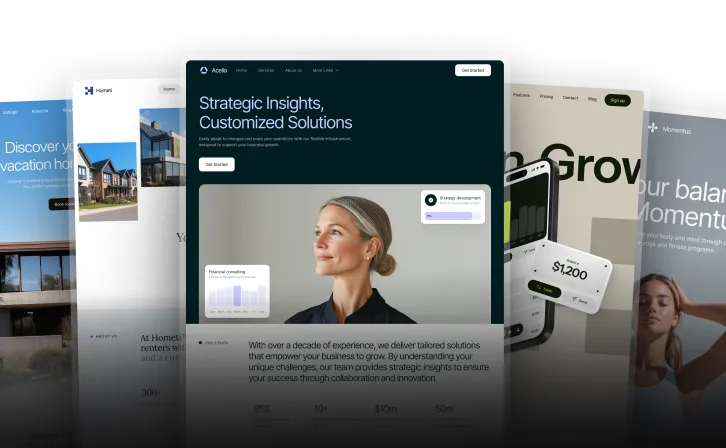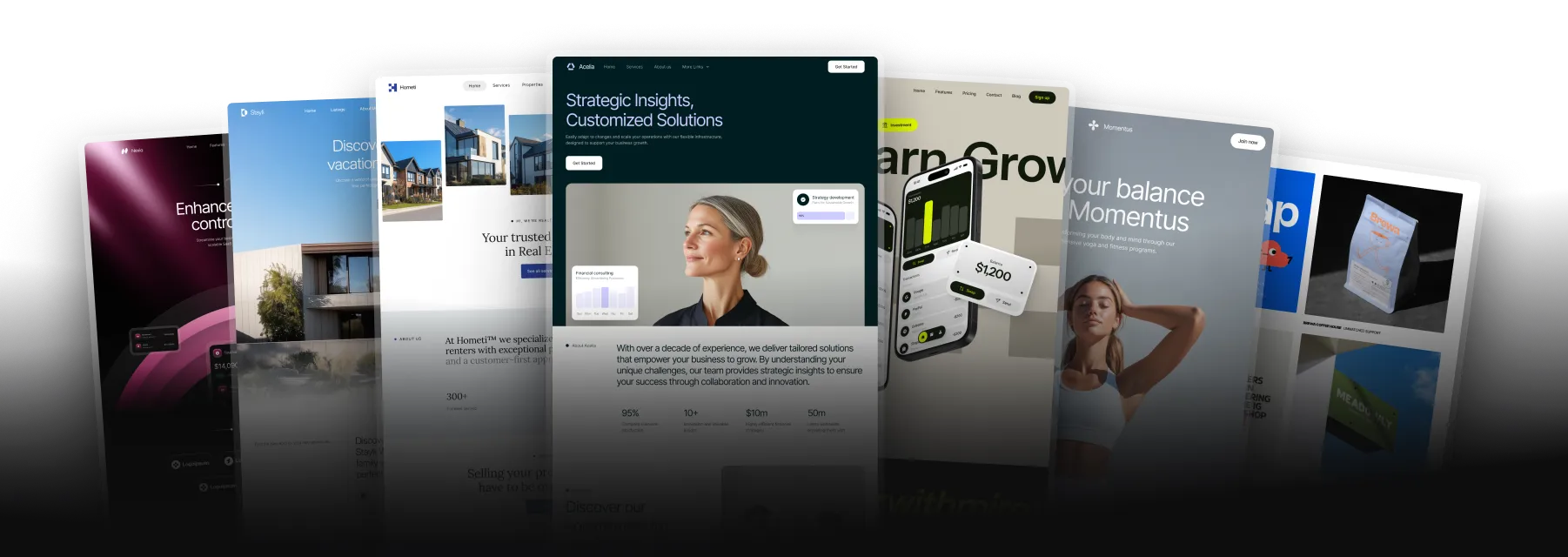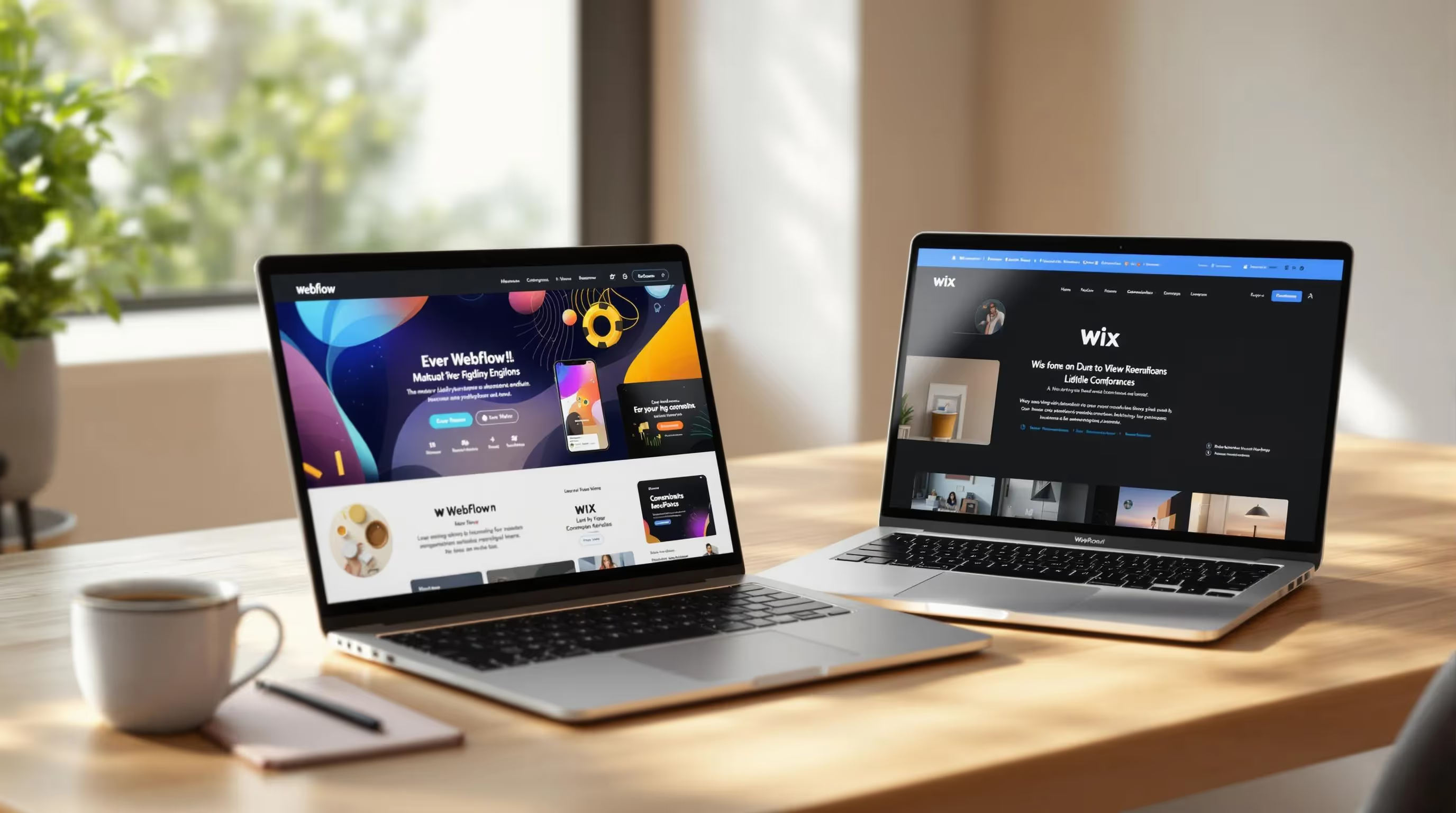Webflow vs Wix: Which Website Builder is Right for You
Unlock all templates




Choosing between Webflow and Wix depends on your needs. Wix is ideal for beginners and small businesses looking for ease of use, while Webflow caters to professionals and agencies needing advanced design control. Here's a quick comparison:
- Wix: Beginner-friendly, AI-driven setup, 900+ templates, robust e-commerce tools, and lower starting costs ($17/month).
- Webflow: Advanced design tools, 6,000+ templates, full customization, and scalability for professionals (starting at $18/month).
Quick Comparison
| Feature | Wix | Webflow |
|---|---|---|
| Ease of Use | Drag-and-drop, AI setup | Advanced tools, steeper learning curve |
| Templates | 900+ free templates | 6,000+ marketplace templates |
| E-commerce | Supports 50,000 products, 100+ payment gateways | 15,000 products, 2 payment gateways |
| Starting Price | $17/month | $18/month |
| Best For | Beginners, small businesses | Designers, agencies, enterprises |
Read on to explore features, costs, and which platform suits your project.
Wix vs Webflow (2024) - Which is the Better Website Builder?

Getting Started: Platform Basics
Wix: Easy Website Creation Without Code
Wix makes building a website straightforward with its drag-and-drop interface. During setup, its AI tool asks a few questions about your business and creates a site plan in just about three minutes. With over 900 templates available, it’s perfect for beginners looking to get a website up and running quickly, no coding skills required. Now, let’s look at how Webflow caters to more advanced users.
Webflow: Tools for Advanced Designers
Webflow skips the AI onboarding but provides powerful design tools that don’t require coding. While it only comes with a limited number of built-in templates, you can access a marketplace with over 6,000 options. Its advanced features give designers complete control, but they come with a learning curve. This platform is ideal for those aiming for a professional, polished website.
Comparing Learning Resources
The differences between Wix and Webflow also extend to their learning resources. Here’s a quick breakdown:
| Learning Feature | Wix | Webflow |
|---|---|---|
| Initial Setup Time | ~30 minutes | Several hours to days |
| AI Assistance | Built-in AI chatbot | AI tools for specific elements |
| Learning Resources | Guided checklist, tutorials | Webflow University, Made in Webflow |
| Template Options | 900+ templates | 6,000+ marketplace templates |
For those diving into Webflow, Finsweet suggests exploring several Webflow University courses to speed up the learning process.
Design Tools and Options
Wix Template System
Wix offers a straightforward design experience with over 900 templates. Its drag-and-drop editor makes customization easy, no coding required. However, this simplicity can limit how much you can tweak your designs.
For users wanting more control, Wix introduced Wix Studio. This platform combines ease of use with advanced tools like custom CSS and no-code animations, making it a better fit for professional designers.
Webflow Design Features
Webflow takes design to the next level with tools for pixel-perfect customization. You can fine-tune spacing, positioning, backgrounds, borders, and more, giving you full creative control.
Another standout feature is Webflow's component system, which allows you to create reusable design elements. This is especially handy for agencies or brands working on large-scale websites, as it ensures design consistency while reducing potential mistakes.
Mobile Design Comparison
Wix and Webflow handle mobile responsiveness in distinct ways:
| Feature | Wix | Webflow |
|---|---|---|
| Design System | Adaptive design with AI help | Fully responsive using Flexbox |
| Device Optimization | AI creates unique versions | Manual control over breakpoints |
| Customization Level | Limited mobile editing | Full control across devices |
| Design Process | Automated with manual tweaks | Built-in responsive tools |
Wix leans on automation to simplify mobile design, while Webflow gives designers full control using tools like Flexbox. This makes Webflow a favorite for agencies and brands aiming for polished, consistent designs across all devices.
sbb-itb-fdf3c56
Online Store Features
Wix Store Tools
Wix provides a powerful e-commerce platform packed with built-in tools to support your online store. It ensures 99.99% uptime and can handle up to 45,000 transactions per minute. Its inventory management system allows for flexible stock tracking, making it easier to manage your products.
Some standout features include native POS integration, support for over 100 payment gateways, built-in abandoned cart recovery, subscription selling, and Amazon multichannel integration, which has been shown to increase revenue by 26%.
Webflow Store Tools
Webflow focuses on giving users advanced design flexibility while offering basic e-commerce capabilities. It allows full customization of cart and checkout experiences. However, there are some limitations to consider:
- Supports fewer products compared to Wix
- Only offers two payment gateway options
- Requires third-party tools for digital downloads
- Lacks built-in subscription management
- Needs external tools for abandoned cart recovery
E-commerce Features Table
| Feature | Wix | Webflow |
|---|---|---|
| Product Limit | 50,000 items | 15,000 items |
| Monthly Transaction Fee | None | 2% (entry-level plan) |
| Starting Price | $29/month | $42/month |
| Payment Gateways | 100+ options | 2 options |
| Built-in Marketing Tools | Comprehensive suite | Basic features |
| POS Integration | Native system | Third-party only |
| Order Processing | Up to 45,000/minute | Not specified |
| Inventory Management | Advanced tracking | Basic tracking |
Pick the platform that aligns with your business needs, whether you prioritize scalability or design flexibility.
Cost Breakdown
Wix Plan Options
Wix offers several premium plans tailored to different needs:
- Light: $17/month – Includes 2GB storage and 2 collaborators.
- Core: $29/month – Offers 50GB storage, basic e-commerce features, and 5 collaborators.
- Business: $36/month – Provides 100GB storage, standard e-commerce features, and 10 collaborators.
- Business Elite: $159/month – Includes unlimited storage and supports up to 100 collaborators.
All business plans come with payment processing through Wix Payments, which charges 2.9% + $0.30 per transaction. Additionally, premium plans include a free domain for the first year.
Webflow Plan Options
Webflow divides its pricing into Site Plans and E-commerce Plans, billed annually:
-
Site Plans:
- Basic: $14/month – Includes 10GB bandwidth.
- CMS: $23/month – Offers 50GB bandwidth and supports up to 2,000 CMS items.
- Business: $39/month – Includes enhanced features and increased bandwidth.
-
E-commerce Plans:
- Standard: $29/month – Includes a 2% transaction fee.
- Plus: $74/month – No transaction fees.
- Advanced: $212/month – Offers additional features with no transaction fees.
Below is a cost comparison to help you evaluate annual expenses for different types of websites.
Website Cost Examples
Here's a table showcasing annual costs for specific use cases:
| Website Type | Wix Annual Cost | Webflow Annual Cost | Notes |
|---|---|---|---|
| Portfolio Site | $204 (Light) | $168 (Basic) | Wix includes an integrated marketing suite. |
| Business Blog | $348 (Core) | $276 (CMS) | Webflow's CMS plan is needed for blogging. |
| Online Store | $432 (Business) | $888 (Plus E-commerce) | Wix provides a more budget-friendly option. |
This breakdown highlights which platform might better suit your project's budget and requirements.
Making Your Choice
When to Choose Wix
Wix is a great option if you're looking for speed and ease of use. With its drag-and-drop interface and AI-driven site creation tools, it's perfect for small business owners or beginners who want to get online quickly. It also includes a full suite of marketing tools like social media management, email campaigns, and SEO features.
For e-commerce, Wix can handle larger product inventories compared to Webflow, making it a solid choice for businesses with extensive catalogs. Its pricing is also more budget-friendly, which is ideal for startups and smaller operations.
"Wix is the kind of platform you recommend to your friend who just needs a website: fast. It's intuitive, simple, and gives you results without a lot of effort." - Mia Nguyen
When to Choose Webflow
If you need more control over your website's design, Webflow is the way to go. It's suited for professionals and agencies who need advanced features and scalability. Webflow's component system allows teams to create reusable design elements, ensuring consistency across large projects.
The platform is built for scale, managing up to 15,000 image uploads per hour, 2 million CDN requests per second, 10 million API requests per hour, and over 5 million Lambda functions - all with an impressive failure rate of less than 0.001%.
"Webflow is best for brands and agencies building at scale. Its granular control and component system let you create reusable design elements that clients can't break, making it perfect for agencies and enterprises." - Ryan Kane
Platform Selection Guide
Here's a quick breakdown to help you decide:
| Business Type | Recommended Platform | Key Deciding Factors |
|---|---|---|
| Small Business/Startup | Wix | AI-driven setup, built-in marketing tools, lower cost |
| Design Agency | Webflow | Component system, team collaboration, code export |
| E-commerce (Large) | Wix | Higher product limit, integrated marketing |
| Portfolio/Creative | Webflow | Precise design control, custom animations |
| Enterprise | Webflow | Scalability, clean code export, advanced collaboration |
Consider your business needs when making your choice. Wix is ideal for beginners who want a straightforward setup, while Webflow offers the advanced tools and flexibility professionals need.
Related Blog Posts
Recommended posts
Unlock all templates







